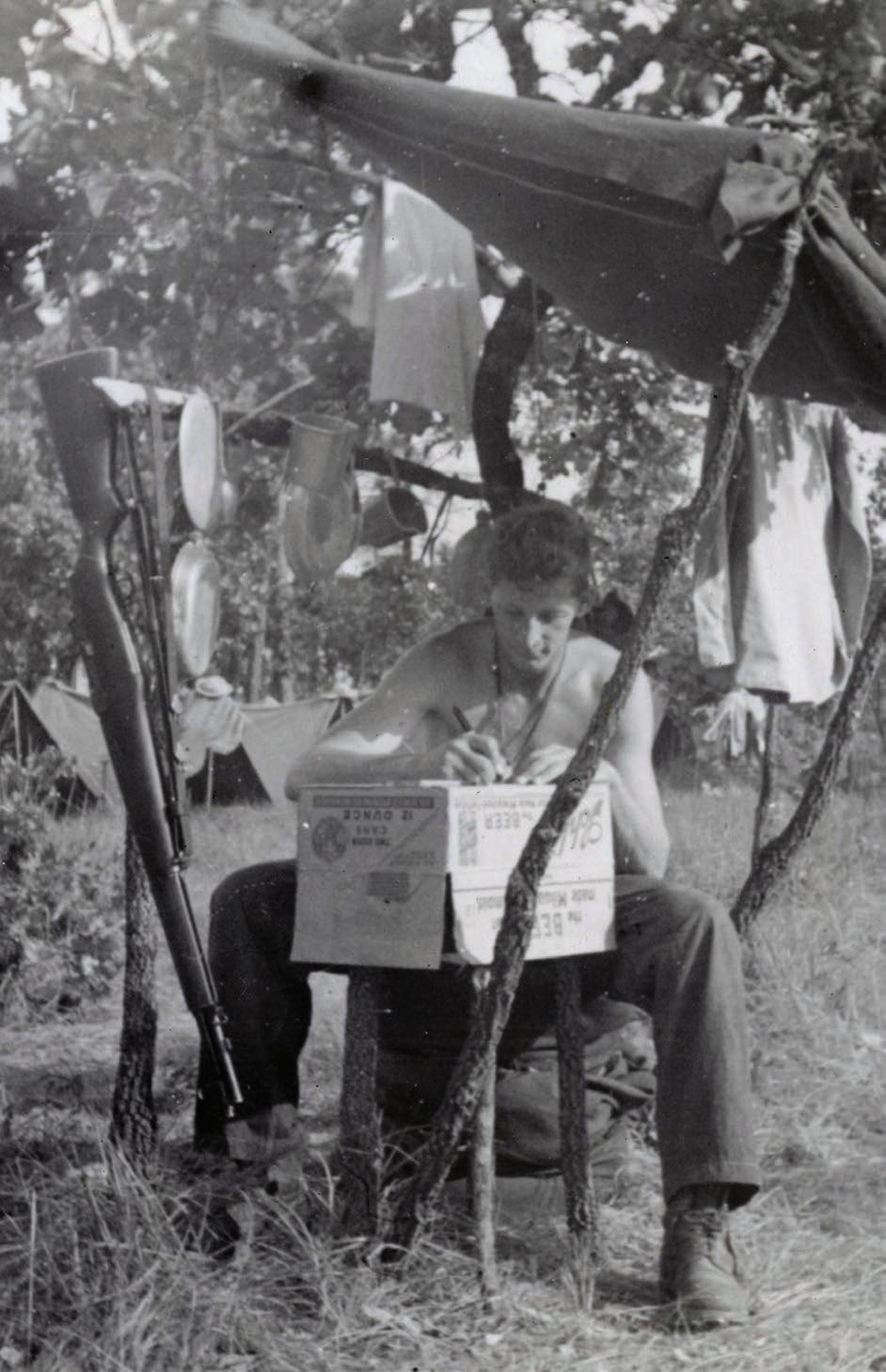
THE BUGLE 1
WINTER 2020 | VOLUME 27:4
BU G LE THE
“Bivouac
Gerald L. Endl was born in Fort Atkinson and later moved to Janesville, Wisconsin, enlisted in the Army on 16 April 1941, serving with the 128th Infantry Regiment, 32nd Division. The 32nd Division was training in Louisiana before the United States entered World War II, and while in training, Endl, out on bivouac, took time to write home in his makeshift shelter. Featured in the cover photo is Endl as he writes a letter on an upturned Schlitz beer box.
The 32nd Division was initially going to be deployed to England, but with the changing war in the South Pacific, was re-routed to service there. Staff Sergeant Gerald L. Endl became the 11th Wisconsinite to receive a Medal of Honor for conspicuous gallantry and intrepidity on July 11, 1944, during Operation Cartwheel. Gerald Endl was killed in action on July 11, 1944 while attempting to save the lives off all of his comrades. He is buried in the Saint Joseph Catholic Cemetery, Fort Atkinson, Wisconsin. WVM.1541.I049.02
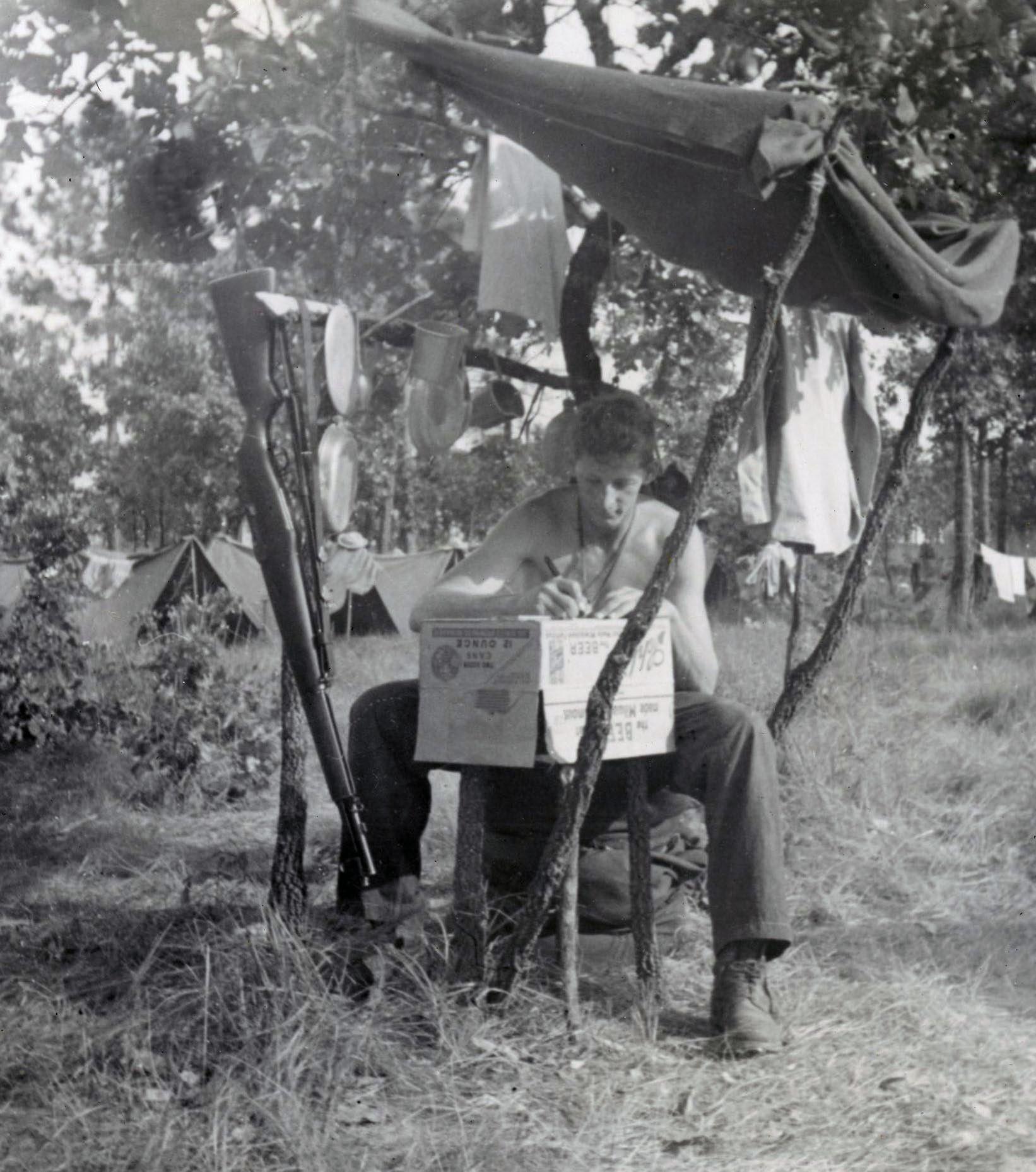
7 | FROM THE DIRECTOR 8 | FROM THE SECRETARY 10 | EVERY VETERAN IS A STORY 12 | FROM THE ARCHIVES 14 | BRANCHES OF SERVICE FEATURE 18 | FROM THE COLLECTION 20 | ORAL HISTORIES DESERT STORM 22 | A DESERT STORM DEPLOYMENT 23 | CALENDAR OF EVENTS 24 | FROM THE FOUNDATION 28 | THANK YOU DONORS COVER IMAGE
area, writing home”
MUSEUM STAFF
DIRECTOR
CHRISTOPHER L. KOLAKOWSKI 608.266.1009
ASSISTANT DIRECTOR
JENNIFER VAN HAAFTEN 608.261.6802
OPERATIONS ASSISTANT
ELISE MCFARLANE 608.261.0534
ORAL HISTORIAN
LUKE SPRAGUE 608.261.0537
CURATOR OF HISTORY
KEVIN HAMPTON 608.261.5409
PROCESSING ARCHIVIST


BRITTANY STROBEL 608.800.6958
COLLECTIONS MANAGER
ANDREA HOFFMAN 608.800.6957
REFERENCE ARCHIVIST
RUSS HORTON 608.267.1790
REGISTRAR
SARAH KAPELLUSCH 608.800.6955
CURATOR OF EXHIBITS
GREGORY KRUEGER 608.261.0541
STORE MANAGER
GREG LAWSON 608.261.0535
SENIOR MARKETING SPECIALIST



JENNIFER STEVENSON 608.264.6068
ART EXHIBIT COORDINATOR

YVETTE PINO 608.266.1854
EDUCATION SPECIALIST
ERIK WRIGHT 608.264.7663
THE WISCONSIN VETERANS MUSEUM
30 WEST MIFFLIN STREET
MADISON, WI 53703
ON THE CAPITOL SQUARE
608.267.1799
www.wisvetsmuseum.com
FOUNDATION
BOARD OF DIRECTORS
PRESIDENT
DAN CHECKI
VICE PRESIDENT
JOANE MATHEWS
TREASURER
DAN HEILIGER
SECRETARY
TOM HUISMANN
DIRECTORS AT LARGE
DAN GREENE
WILLIAM F. HUSTAD
TIMOTHY LA SAGE
JOSEPH NAYLOR
PHIL PRANGE
BOB SIMMONS
NATHANIEL T. MILLSAP, JR.
ALEJANDRO ARANGOESCALANTE
COMMENTS & SUBMISSIONS
We welcome your comments and editorial submissions concerning The Bugle. Comments and submissions should be sent to Jennifer Stevenson at jennifer.stevenson@dva. wisconsin.gov
In the interest of the health and welfare of our guests, staff, and volunteers, the Wisconsin Veterans Museum remains closed.
Please continue to visit our website for updates on our re-opening plans and to experience our virtual museum content.
We are still open for phone or email inquiries at 608-267-1799 or veterans.museum@dva. wisconsin.gov.

We continue to closely monitor the status of COVID-19 in Wisconsin and will reopen to visitors as soon as practicable. Thank you for your understanding and for joining us to help prevent the spread of disease.
FOUNDATION STAFF
EXECUTIVE DIRECTOR
JENNIFER CARLSON
608.261.0536
JENNIFER.CARLSON@WVMFOUNDATION.COM
COLLECTION DONORS
9/9 –11/9/2020
A most sincere thank you to all who donated to our collection from September – November 2020. Thank you for your generosity and support of the Wisconsin Veterans Museum.
DENNY BEHR
JOHN GERGLE, JR.
Join Us Online

MUSEUM MISSION
The mission of the Wisconsin Veterans Museum is to commemorate, acknowledge, and affirm the role of Wisconsin veterans in America’s military past and present.
THE BUGLE is published quarterly for our members and friends through the support of the Wisconsin Veterans Museum Foundation. The Wisconsin Veterans Museum Foundation provides funds for the support of artifact acquisitions, exhibit production, and the development of educational programs.

4 WINTER 2020 THE
THE BUGLE 5
BUGLE
Bugler George “Goldie” L. Campbell
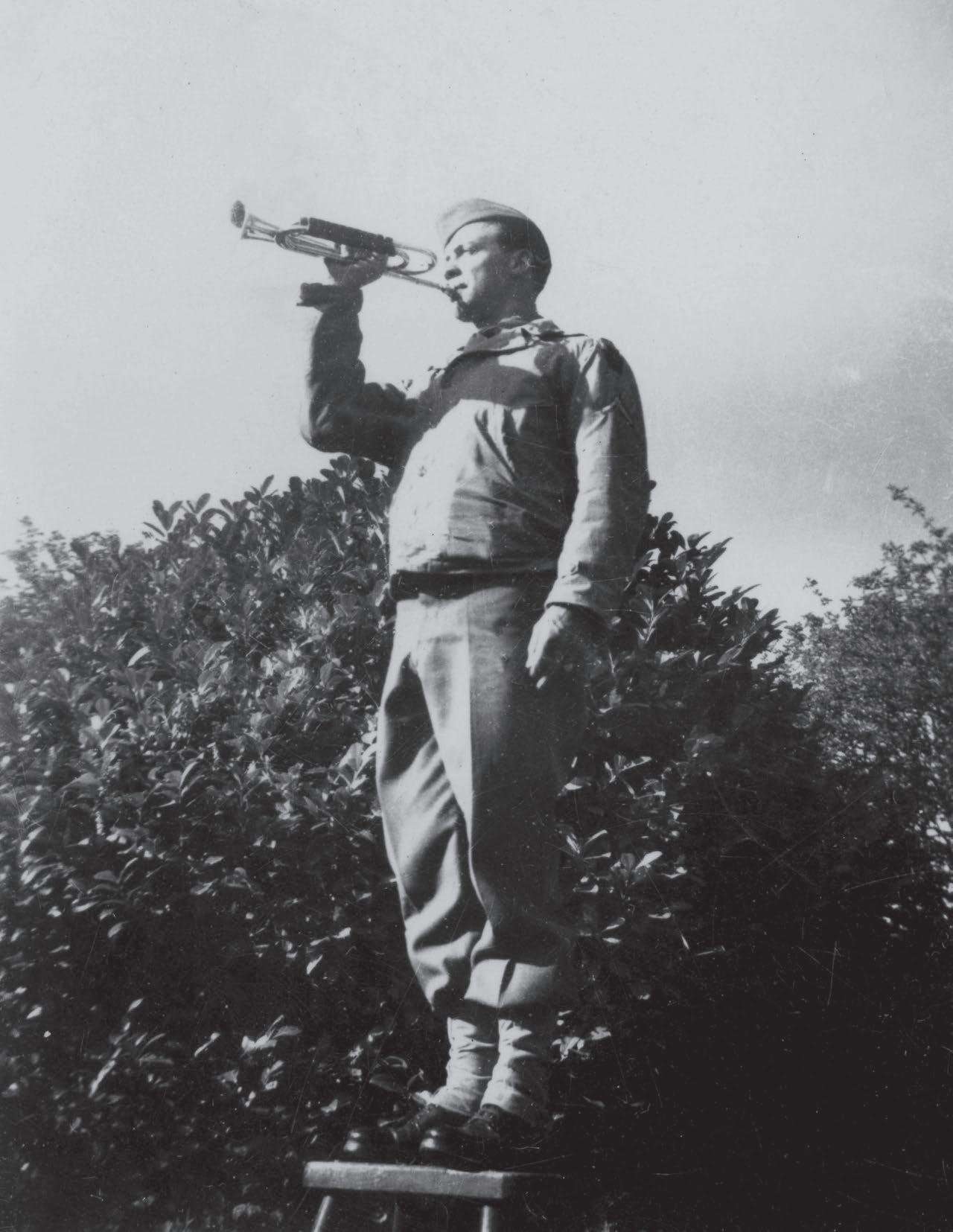
From the collection of George “Goldie”
L. Campbell. Campbell, an Ellsworth, Wisconsin resident, served with the radio section of the 110th Infantry Regiment, 28th Division, 2nd Battalion in World War II. The 28th Division was deployed to Europe, and Campbell saw combat in the Battle of the Bulge. In his reminiscences, Campbell reflects on his time in Belgium in December 1944, and finding he was one of around 550 men trapped on a hilltop, surrounded by Germans, and his journey through enemy lines to find his way back to the Allied lines. Campbell returned home to continue studying education, working as an educator and administrator in Wisconsin public schools. George Campbell died June 10, 1999, and is buried in the Saint Francis Cemetery, Ellsworth, Wisconsin. TR1208.I070
FROM THE DIRECTOR
Dear Friends of the Wisconsin Veterans Museum
Greetings! I hope this finds all of you well and enjoying this holiday season. I’m coming up on my one-year anniversary as director, and it is amazing time has flown so quickly. It has been a dynamic year for sure, filled with challenges but also opportunities. We’re looking forward to 2021 and its myriad of possibilities.
This issue covers a lot of interesting topics. One of the largest you will see is the 30th anniversary of Desert Storm, which starts in January 2021. It is hard to believe three decades have passed since that titanic victory over Saddam Hussein. That war, occurring as it did at the end of the Cold War and spawning conflicts in the Middle East since, more and more seems to be a hinge on which the history of the last three decades has turned.
In this issue, we also introduce you to the staff and their veteran family members. In my first message I alluded to my Wisconsin veteran roots, and you will see some of my ancestors in here. Many more staff members have veteran ties or are veterans themselves and they have voluntarily shared their stories. Reading these submissions, you see where the staff’s personal connection and passion for the museum and its mission come from. It also drives home one of our key messages Every Veteran Is a Story.
The elite team here continues to come up with creative methods and solutions to meet our mission of preserving and telling the stories of Wisconsin veterans. There is a lot happening online, and I encourage everyone to see what is available at our website. We are taking advantage of our closure to also work behind the scenes on our exhibits and collections, so that the museum presents a refreshed look when we reopen to the public. All of this is being done with the critical help and support of the Wisconsin Veterans Museum Foundation.
We continue to look to history for perspective and inspiration. We as a people have endured worse and still survived and advanced. I am confident that going forward we will again do the same. “Perpetual optimism,” said General Colin Powell, “is a force multiplier.”
Best wishes to all of you for the New Year and thank you for your continuing support. Hope to see you at the museum soon.
Best,
Chris Kolakowski
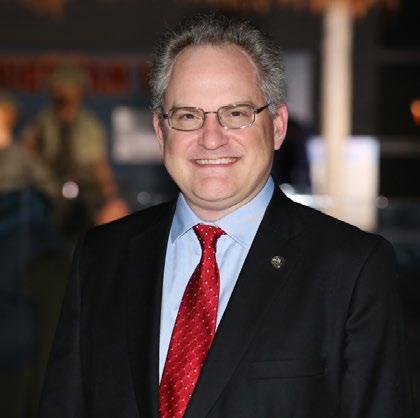
THE BUGLE 7
As many of you are aware, in June and throughout the following four months, the exterior of the building in which the Wisconsin Veterans Museum is located, along with many other buildings in downtown Madison, were damaged by graffiti, reflecting the strife that continues across our country. We share in the pain that so many in our state and country feel. Our museum contains the artifacts and stories of Wisconsin veterans who have offered everything up to and including their lives — in service to our country. It exists for all citizens and shares the history of all veterans, men and women of all eras and colors. The museum’s motto, “Every Veteran is a Story,” is very appropriate for this national treasure.
To honor our state’s veterans, the Veteran Print Project stepped forward to develop and produce murals that extend the stories of Wisconsin veterans from the inside of our museum to the street level surfaces of the building. Veteran Print Project, created by Yvette Pino, an Iraq veteran who also works as an art curator at the museum, brings artists and veterans together in dialogue to visualize their experiences through the traditional methods of fine art print. With the non-profit Dane Arts, Veteran Print Project worked within our community to depict Wisconsin veterans, tell their stories, and raise awareness of the contributions of veterans that continued beyond their military service. Represented in the murals are eight inspiring Wisconsinites who have served our nation from the Vietnam War to present day:
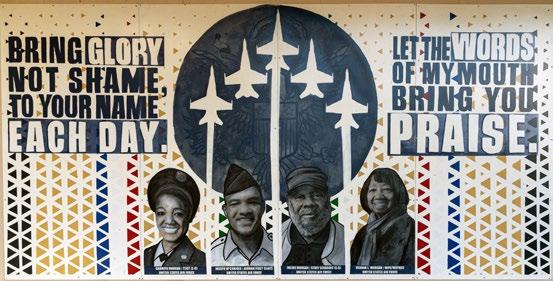
• Marcia Anderson, the first Black woman in the United States Army Reserve to attain the rank of major general (portrait by Portia Adney, daughter of a veteran; lettering by Wade Lambrigtsen, U.S. Marine Corps veteran)
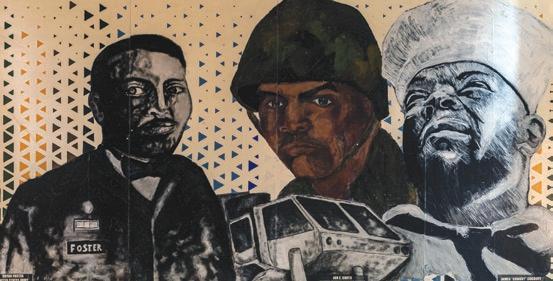

• Bryan Foster, U.S. Army veteran who opened the first Black funeral home in Madison history (portrait by Scott Lenaway, U.S. Army veteran)
• Jon E. Smith, U.S. Marine Corps veteran (self-portrait)
• James “Groovy” Cocroft, U.S. Navy veteran (portrait by A.H. Romero, U.S. Army veteran)
• Carolyn Morgan, a Gulf War veteran and Madison’s first Black Veterans of Foreign Wars post commander, who shares a family legacy of service in the U.S. Air Force with her father, Julius Morgan, and son Joseph McGonigle (portraits by Shawn Ganther, U.S. Air Force veteran)
• Will Williams, U.S. Army veteran (portrait by Jerry Butler)
In addition to the artwork, Madison’s Poet Laureate Emeritus, Fabu, daughter of a Vietnam veteran, generously shared her poems that can be read alongside the murals.
I hope the people whose images are represented in this artwork will inspire us to have the courage and commitment to ensure true justice for all. In the past, we have worked together to address inequities and disparities. We must increase our efforts now and in the future.
Thank you to the veterans and artists who dedicated your time and phenomenal skill to creating this art. All who pass by these images will see the diversity and commitment of Wisconsin veterans and a visual presentation of who they are and how much they have and continue to contribute to our country.
 Mary M. Kolar, Secretary Wisconsin Department
Mary M. Kolar, Secretary Wisconsin Department

of Veterans Affairs
Alongside the murals installed recently at the Wisconsin Veterans Museum are poems by Madison’s Poet Laureate Emeritus, Fabu, daughter of a Vietnam veteran. Four murals, organized by the Veteran Print Project, cover the State Street and Mifflin Street facades.
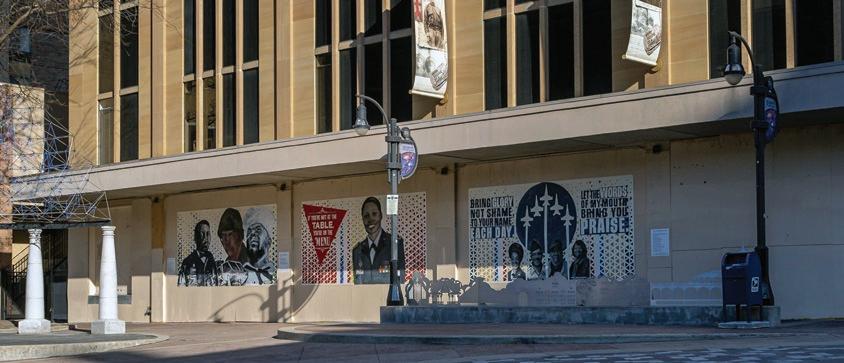

8 WINTER 2020 THE BUGLE THE BUGLE 9
SECRETARY FROM THE
Major General Marcia Anderson, U.S. Army Reserve, portrait by Portia Adney and Wade Lambrightsen.
Family legacy of U.S. Air Force service: Carolyn Morgan, her son Joesph, her father Julius and mother Verona, portraits by Shawn Ganther.
Bryan Foster, U.S. Army, portrait by Scott Lenaway, Jon E. Smith, U.S. Marine Corps veteran, self-portrait, James “Groovy” Cocroft, U.S. Navy veteran, by A.H. Romero.
Will Williams, U.S. Army veteran, portrait by Jerry Butler.
EVERY VETERAN IS A STORY
Carmen Barnes, a Waupaca native, volunteered to serve in the Women’s Army Corps (WAC) during World War II. Upon her enlistment, her father Bradley, who had served in World War I, gave her the Soldier’s Creed booklet that he carried during his service. She spent the majority of her service with the 109th WAC Detachment of the 9206th Technical Service Unit at Camp Stoneman, California. Following her service, Carmen led the effort to form an all-female American Legion Post in Wisconsin, which was chartered in 1952 as the Madelyn LaCanne Post 539 in Green Bay.
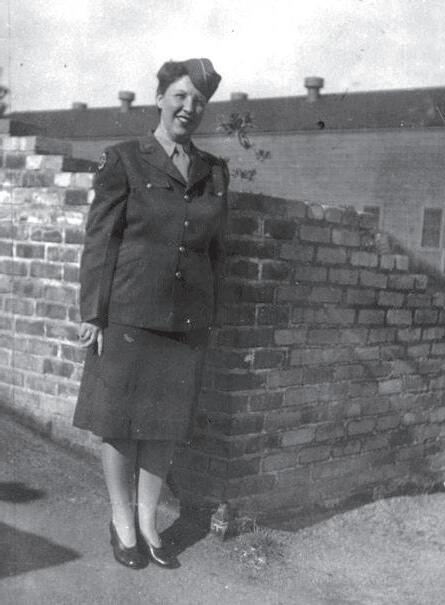
The Wisconsin Veterans Museum proudly preserves her story through the papers, photographs, and her father’s Soldier’s Creed booklet.
 By: Russell Horton Reference Archivist
By: Russell Horton Reference Archivist

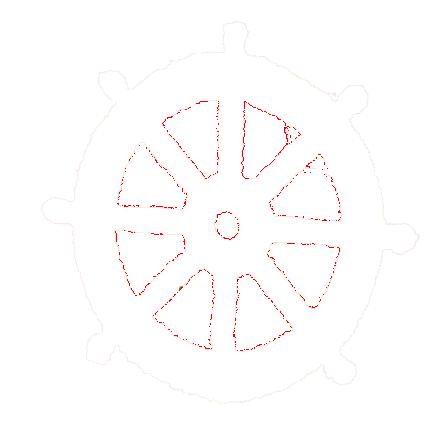

Mike Weber, a Lancaster resident, served as a photographer for the 28th Public Affairs Team of the US Army during Operation Desert Storm. In particular, he documented the actions of the 82nd Airborne Division during the ground phase, from staging in Kuwait to the charge into Iraq. He captured the moments of American soldiers taking prisoners of war and confiscating ordnance as well as interacting with civilians and enjoying downtime. He has also been very open about his struggles with Gulf War Syndrome, which many veterans from that conflict face. An immensely talented photographer, the Wisconsin Veterans Museum exhibited a selection of Weber’s images in 2011.
The Wisconsin Veterans Museum proudly preserves his story through the papers and photographs that he donated to us.
EVERY VETERAN IS A STORY

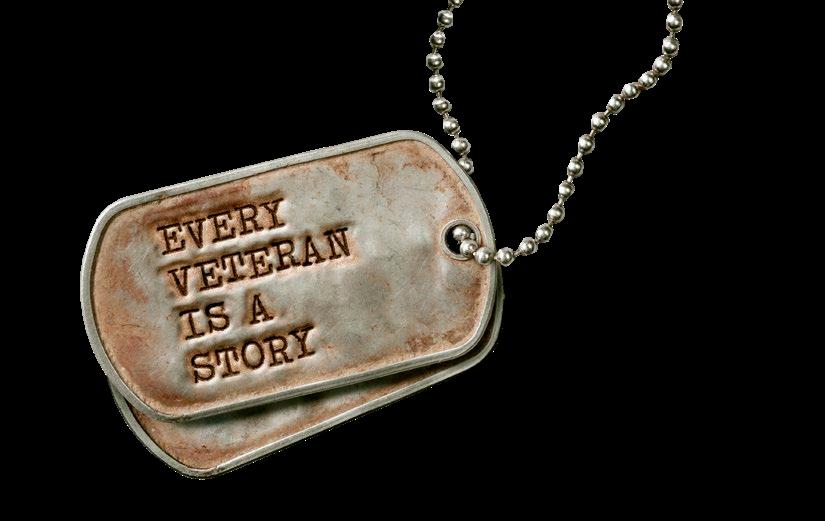

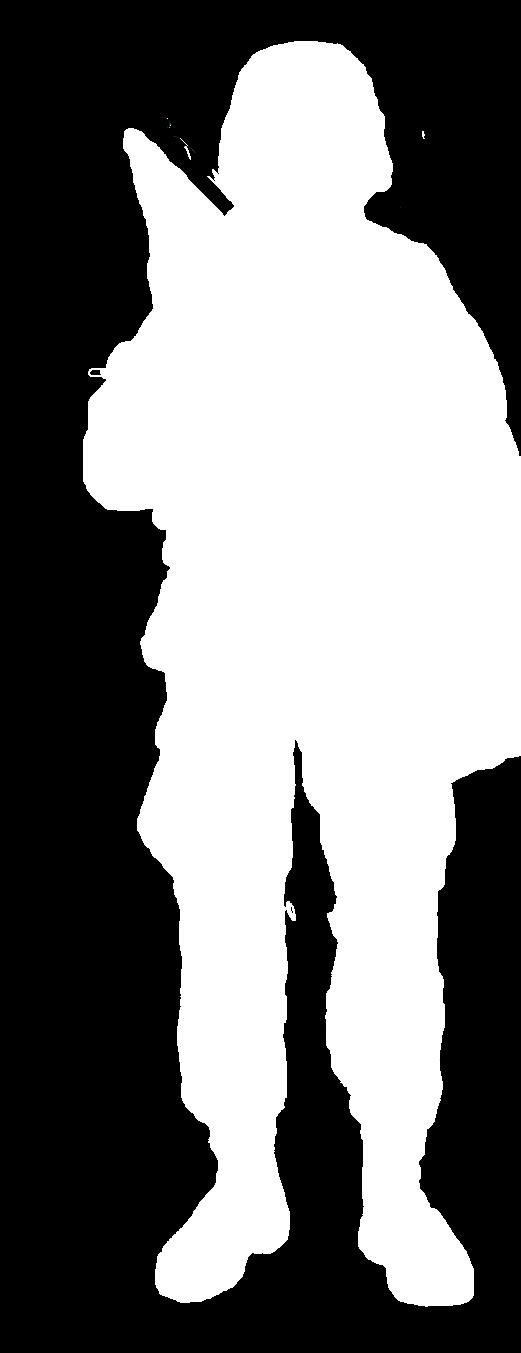
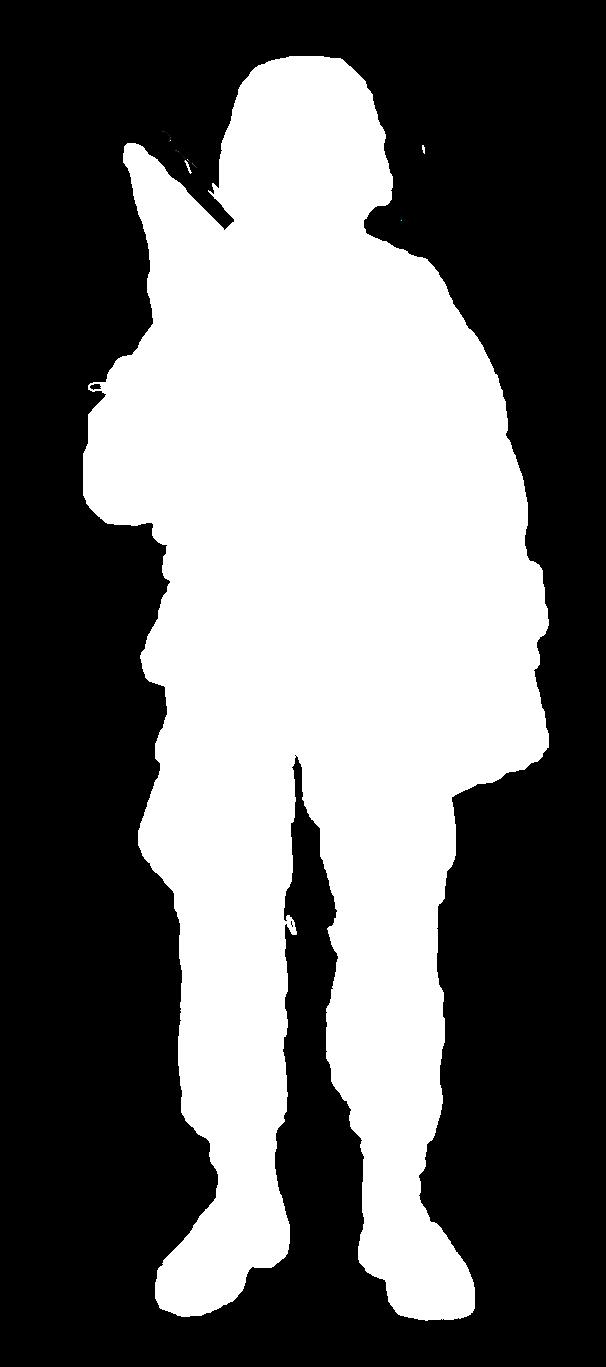
WINTER 2020 THE BUGLE 11
Family-Style Service
Stories of Wisconsin Military Families
By Brittany Strobel Processing Archivist
Collections in the Wisconsin Veterans Museum archives document the experiences of service members through their life in service, and after as veterans. Letters, diary entries and photographs form the cornerstone of most collections. By their personal nature, these documents introduce us to other players in their life story, especially family members and
friends. Letters to and from family, friends, and fellow veterans allow readers to experience a fuller picture of service through the eyes of a veteran. Part of our work to preserve the stories of Wisconsin veterans is to help families connect with history through those family stories. We help people with genealogy, provide copies of collections for families, and occasionally surprise people with stories of their veterans. This is a small sampling of the appearance of families within the museum archives.
The McNown Family
The Manicke Family
John McNown, born on the Isle of Man, moved to Lemonweir, Wisconsin through Canada, with his wife Jane [Bagnell] and six of their eight children, two of whom were born in Wisconsin. When they arrived in 1833 and started farming, the McNown family was one of the first settling families in the area. On October 9, 1861, John McNown enlisted in Company F, 16th Wisconsin Infantry Regiment. Shot and carried off the field at the Battle of Shiloh, John died from his wounds and was buried in what became the Shiloh National Cemetery at Shiloh, Tennessee. His son Isaac A. McNown, a resident of Mauston, Wisconsin, joined Company B, 2nd Wisconsin Cavalry Regiment following the death of his father in 1862.
The image of John, housed in a tintype case, has been printed on glass with a flaking back. The image is a copy print of an original tintype. When examining the photograph, the decorative metal frame of the original tintype can be seen in the image, which is distinctly different from the metal frame of the glass reproduction. While cartes-de-visite were reproducible, tintypes are a direct process, resulting in a single image with no negative to re-print. If there was any desire for additional portraits, families and photographers had to be creative to reproduce the one-of-a-kind photographs. The image of Isaac is a gemtype, which is a tintype on 1/16th of the image sheet, and has been mounted onto paper backing and framed with a smaller metal frame.


Stanley and Lucy Manicke had nine children four boys and five girls all born in Thorp, Wisconsin. Featured here are four of the Manicke siblings: Daniel, Lillian, Paul and Stanley Jr., in a photograph noted to have been taken in Hartland, Wisconsin where the Manicke parents had moved to during World War II. Daniel served as an electrician’s mate in the navy aboard the USS Eldorado and LST 25. Lillian served as a clerk-typist in the United States Marine Corps Women’s Reserve. Paul served as a clerk-typist with the Army Air Force in the South Pacific. Stanley Jr. served as a litter bearer with the 436th Medical Collecting Company in Europe. All four siblings returned to Wisconsin after their service, with a younger brother John serving in the army post-World War II.

The Aronson Family
Brothers George, Leonard, Maurice, and Sammy Aronson served in World War II. While in service, the four brothers wrote home to their brother, Harry, who operated a clothing store in their hometown of Oconto, Wisconsin. George, born in 1919, served in Europe in the Quartermasters Corps; Leonard, born in 1916, served with the 14th Infantry Division; Sammy, born 1921, served in the 955th Field Artillery Battalion; Maurice, born 1925, served in an Armored Division. While in Europe, Sam and Leonard were able to meet up on furloughs. A younger brother, Arthur, born 1930, served in the Korean War.

12 WINTER 2020 THE BUGLE THE BUGLE 13
ARCHIVES
THE
FROM
John McNown WVM.2273.I001.07
Isaac McNown WVM.1859.I001e
The four Aronson brothers who served in World War II. WVM.0711.I001
Daniel, Lillian, Paul and Stanley Jr. photographed in Hartland, Wisconin. IMG20201022_09380576
Branches of Service









Museum Staff Share Their Familial Connections to the Armed Forces

As is true for most professions, a person needs some affinity for the work they do to feel fulfilled on the job. This truth is no different for the staff at the Wisconsin Veterans Museum. For many of us, the attraction to telling Wisconsin veterans stories has been gained through our own military service, or that of family members. With this article, we hope you enjoy learning about our dedicated staff through their connections to the armed forces.
Beth Stofflet Education Staff
When the Army Active Reserve, 380th Military Intelligence Detachment of Madison, was called up for ten months of active duty because of the Berlin Crisis, the three-year old version of me thought her daddy was living on the plane all of that time. I’m Beth Stofflet and I work in the education department. My job includes sharing the stories of Wisconsin veterans as a docent, providing resources to educators, and helping to arrange special events, now online during the pandemic. Through my work, I have learned more about the service and sacrifice, often at heroic levels, that our veterans have made. Behind each of those veterans is also the personal story of the family that waits for their return.
When my father, 1st Lt. Frank Skonie, was called up, his wife and four children, with another on the way, waved good-bye as his plane took off from Truax Field. While he was gone, neighbors pitched in to help shovel snow. Grandpa came to town periodically to help with maintenance around the house, and drove my mother to the hospital when it was time to give birth to my brother things my father would have preferred to do. In this photo, a local newspaper captured the happy family reunion along with my dad’s introduction to his new son.
Jennifer Van Haaften Assistant Director
I am Jennifer Van Haaften and, as assistant director, I contribute to all aspects of the museum’s work from collections to visitor services, security to budget, programs and marketing to exhibits. Military service in my family reaches all the way back to the Revolutionary War and also includes the Civil War and World War I. My great uncles and my grandfather served during WWII and my uncle served in the Navy during the Vietnam era. My grandfather, 1st Lt. Laurence Higgins, served in the 168th Infantry Regiment, 34th Infantry Division during World War II. He saw combat in North Africa where he was wounded and captured. He recuperated in an Italian hospital and then was sent to a POW camp in Poland until 1945. This photograph of the officers was taken at the POW camp. He is the one in the second row, far right. He was released as part of a prisoner exchange and shipped back to the U.S. before that camp was abandoned and remaining prisoners were forced to march to another location. My family originally hails from Iowa, but there’s no one
perfect museum to give military collections to in Iowa, like there is in Wisconsin. Wisconsin gathers and cares for these stories and the objects, papers, and photos that enhance the understanding of military service of ordinary Wisconsinites at the Wisconsin Veterans Museum.
I am Chris Kolakowski, director of the Wisconsin Veterans Museum. It is my honor to be in charge of this great institution and its elite team.
The first photo shows me as an infant with my paternal grandparents, Boleslaw (Boris) and Georgina Ritson Kolakowski. Grandpa was born in Baltimore in 1916, and his parents took him back to Poland when the independent country was reborn after World War I. Raised Polish, in 1939 he was a corporal in the Polish Army, stationed in the northeastern part of Poland as part of the Border Protection Corps. When the Soviets invaded Poland, his unit crossed into Lithuania and was interned. A year later the Soviets invaded Lithuania, and he ended up in the gulag until 1942 when released under a general amnesty. He escaped the USSR with the Anders Army and transferred to the United Kingdom where he served as a Leading Aircraftsman in the Polish Air Force (attached to the RAF) from 1943 to 1947. He told my dad once that part of his duties included working in the library of the British Army Museum because he knew how to bind books. In London, he met my grandmother (who worked as a telephone operator in the Admiralty and had family fighting all over the world) in an air raid shelter during a V-2 strike in late 1944. They married in February 1945, and at war’s end chose not to go to Communist Poland. Grandpa claimed his U.S. citizenship, and in June 1947 they sailed for New York on the liner Aquitania. He died in 1982, not having seen Poland since September 1939.


The second photo is my maternal grandfather, John A. Steffen. Born in Elroy, Grandpa graduated from high school in 1944 and was drafted shortly thereafter. He was inducted into the Army in Milwaukee on October 25, 1944, and did his basic training at Fort McClellan, Alabama, before shipping to Europe in March 1945. There he was assigned to the reconstituted 423d Infantry Regiment of the 106th Infantry Division, and ended up on the siege lines at Lorient, France where he ended the war in Europe. The division was scheduled for the invasion of Japan, but the atomic bombs stopped its transfer. Instead, he stayed in Europe and was assigned to 3d Armored Division and later 1st Armored Division for duty in the occupation of Germany at Tauberbischofsheim. He played trumpet in the 81st Reconnaissance Squadron Band until returning home for discharge in July 1946. His final rank was Staff Sergeant, his NCO status a lifelong source of pride. He died in 2016 and is buried in Madison.

Greg Krueger Curator of Exhibits
I am Greg Krueger the curator of exhibits at the museum. I ensure our exhibits and displays look pristine, that they are inclusive of all Wisconsin veterans, and that are accessible to as broad of an audience as possible.
My father, Cal, served in the army during the early 1960s. Anxious to get out of Milwaukee and experience more of life, he graduated from Juneau High School in 1961 and joined the army with a group of buddies. Being familiar with airplanes, (his father owned and operated one and flew to family vacation destinations) Cal decided it would be fun to jump out of them. He went through basic training at Fort t Benning, Georgia, and then advanced to jump school at Fort Bragg, North Carolina. He graduated in September 1961, and joined the 82nd “All-American” Airborne Division. After World War II ended and the Cold War formed, the 82nd adopted the role of America’s Strategic Reaction Force. These troops from the sky trained to be dropped into any environment at a moment’s notice and that is what Cal remembers;“We were always playing war,” he said.

WINTER 2020
Chris Kolakowski Director
Kevin Hampton Curator of History
I am Kevin Hampton, the curator of history at the museum. I design exhibits, develop educational programs, conduct research, but, most important, I get to share the stories of Wisconsin veterans to ensure they are never forgotten. My family history is full of stories of service. My grandma was the family historian and genealogist, and I grew up asking to hear those stories over and over again. From “Uncle Joe” who served in France in WWI to John McMahon that served with the 7th Wisconsin in the Civil War and was wounded at the Battle of Gainesville/2nd Bull Run. A favorite was always the story of my fifth great-grandfather, Abijah Hutchinson, who served under General Putnam at the Battle of Bunker Hill in the Revolution, or even as far back as Captain Myles Standish, the military officer aboard the Mayflower in 1620. Without a doubt, the most personal were the WWII stories from my grandpa himself - from his service in Italy, to the loss of his brother in a P-47 training accident in 1945
(Left: Grandpa J. Roger Doherty and his brother Joseph Aaron Doherty pictured). My grandparents and our family stories had an immense impact on my life, both personally and professionally. They taught me that everyone has a story to tell and they need to be shared and remembered. By sharing those stories, we connect the past to our present and future; we learn the true meaning of history. As my grandpa once told me, “We look ahead for a better tomorrow. Look ahead. It’s the only way to look.”
Jen Stevenson Marketing Specialist
As a marketing specialist with the museum, I am in awe of the richness of the stories in the museum collection. In the eight-months I have been on the job, often I have choked up reading stories while prepping them for publication.
Until a few years ago when I began researching my family, I believed we had little military history. After recently connecting with a distant cousin of my dad’s, I discovered my third-great grandfather served in the Civil War only two years after arriving from Hesse, Germany in 1862. Corporal Conrad Schimmel of Company I, 45th Wisconsin Infantry is depicted in the charcoal drawing at left that has been passed down through a cousin’s family. The Wisconsin Veterans Museum holds his service records with which I can confirm those are the blue eyes so prevalent on my dad’s side.

According to other museum Civil War records, my second great-grandfather also served in the 29th Wisconsin in 1862, but deserted in 1863. That explains the mystery of the change in spelling of the family name, enough said.
More honorably, I am married to a 20-year veteran of the U.S. Navy, retired Chief Petty Officer Lorrain Schwager. She enlisted in 1984, served during Desert Storm/Desert Shield on the USS Cape Cod (AD-43), was a company commander, and an electronics instructor. That's just part of her story. Like any retired chief, if you offer her a cup of coffee, she’ll share about 47,000 more salty tales. I couldn't be prouder.
Luke Sprague


Oral Historian


For me, family, the military, and Wisconsin are inextricably bound together. As a boy, I remember asking Grama Ethel, “Was grampa always that way?”
Grama replied that Grampa Cliff had always been a little quirky, but following the three years added to his enlistment during World War II, he was never quite the same. Following V-E Day, Grampa Cliff returned to Stevens Point, Wisconsin, finally married grama after waiting four years, and not long, my father was born. Twenty-five years later in Thorp, Wisconsin, my father received his Vietnam draft notice in the mail. Putting his optometry practice on hold, my parents moved to Fort Sill, Oklahoma. I was born as the last orders for army doctors to deploy to Vietnam were issued to my father’s peers. Fortunately, my father never received those orders and we returned to Thorp.
I began my army career in 1993 (pictured at right). Paralleling my grandfather, I would also find myself serving a year-long-hardship tour overseas, followed by a quick marriage in Wisconsin. Later, I served at Fort Lewis, Washington, with the First Special Forces Group. Continual deployment played a major role in a divorce and the physical toll led to a service-connected disability. I decided to leave the Army to become a historian.
When I serve Wisconsin veterans and their families, I always think about the sacrifices they and their families make, and that guides my actions.
Mike Olson
Assistant Shop Manager
My father’s father, Curtis Olson (Grandpa Curt) from Westby, Wisconsin served in the navy aboard the USS Hornet (CV-12) aircraft carrier during World War II. Thanks to Russ Horton, the Museum’s long-time reference archivist, I know more details about my grandpa’s service. According to his NAVPERS 533 form he served aboard the Hornet as a coxswain. I wish I had asked him more about his service before he passed away in 2009.
My mother’s father, Ross Abbey (Grandpa Ross) from Viroqua, Wisconsin did not serve during World War II due to a deformed arm he suffered from a childhood farm accident. He was drafted briefly during the Korean War, but upon reporting to Fort Sheridan, was honorably discharged, due to his arm. He was in camp long enough, however, to be photographed in his army uniform as seen in this picture at left.
As a boy, I really looked up to my grandfathers and their brothers who served. This admiration inspired an interest in World War II and one I am able to pursue in my work at the museum.
Paul Moriarity Assistant Registrar





As assistant registrar, I work with collections. Many family members served, including myself. I served in the army from 1995-99 and continued in the Wisconsin Army National Guard until 2002. My family is proud of its service, but it has come at a cost. My uncle, Dr. William Tomcek, and my father-in-law, Robert Hackney, were both Vietnam veterans. They were pillars of their families, deeply loved, and lost too early in life to cancers caused by exposure to Agent Orange.



Bill Tomcek (pictured right) served with the 39th Infantry, 9th Infantry Division in the Mekong Delta in 1968. He was reconnaissance man on the front lines. In Vietnam, Bob Hackney served from 1969-70 as an infantryman, radio operator, and combat journalist. He spent time with the 15th Administration Company, 1st Calvary Division moving between Bien Hoa, Tay Ninh and LZ Jamie. Though we miss them dearly, we are proud of their willingness to serve, and for what they endured to get back home to us.

Growing up I did not know very much about my grandfather’s World War II service besides the fact that he walked with a limp because of a war wound. Like many World War II veterans, he didn’t really want to talk about it.
Only after he passed away did my family find a box holding his wartime letters and other military documents that filled in the details of his service. I learned that he served in the 106th Infantry Regiment, 27th Infantry Division. He participated in the invasion of Saipan in the summer of 1944, and there, on July 4, he was shot through the knee. He spent over a year in a stateside Army hospital recovering from nerve damage caused by the bullet wound. This is why he limped for the rest of his life.
Today, I work hard to ensure that the stories of all Wisconsin veterans are preserved for families and researchers. I helped my family decide to donate my grandfather’s World War II letters and photographs to the museum, where my children and their children will be able to see them. And I keep an enlarged photo of my grandfather in my office, looking over my shoulder, to make sure I never forget what a privilege it is to do this important work.
Following the Family Flight Plan
a story of father and son pilots in service
 By Andrea Hoffman Collections Manager
By Andrea Hoffman Collections Manager
For Harold A. Todd Sr and his son Wesley Scott Todd, both having served as pilots in the U.S. military during World War I and World War II, it must have felt like a uniquely shared and yet completely unfamiliar experience. The elder Todd enlisted in the Army Air Service on November 5, 1917 and encountered military flight in its infancy, a mere eight years after the U.S. Army Signal Corps had bought its very first military aircraft. Wesley Scott Todd flew the advanced F4U Corsair aircraft as a World War II fighter pilot for the United States Marine Corps aboard Essex-class aircraft carriers in the Pacific Theater.

Harold A. Todd, Sr was born in Portsmouth, Ohio, and was a newlywed living in Baton Rouge, Louisiana at the time he enlisted. Todd attended the U.S. School of Military Aeronautics at Cornell University and graduated on June 15, 1918. He logged his first solo flight that August aboard a Curtiss JN-4D biplane, and headed to Rockwell, California to attend the Signal Corps Aviation School. He was promoted to 2nd lieutenant before being released from service January 8, 1919. Harold returned home to Louisiana, where he and his wife Fanny Burgess Todd gave birth to their first son, Harold A. Todd, Jr, in 1920. The following year the family relocated to Milwaukee, Wisconsin and welcomed their second son Wesley, whom they called Wes. The family settled in nearby Wauwatosa a few years later.
After Wes graduated Wauwatosa High School in 1939, he left to attend the Citadel Military College in Charleston, South Carolina, not knowing he was to become part of the “class that never was”— the expected class of 1944 from which every member was instead called up for service by their junior year. While most of his would-be graduating class went into the infantry or artillery, Wes decided to instead enlist as a V-5 Naval Aviation Cadet, having taken an interest in flying while at the Citadel and already completed lessons at the nearby Hawthorne Flying Service.

In April 1943, Wes transferred to the Naval Air Training Center in Corpus Christi, Texas after completing primary flight training at Naval Air Station Glenview in Illinois. Two months later, 2nd Lieutenant Todd donned his first Marine uniform. He went on to serve aboard the USS Ticonderoga, USS Essex, and USS Bunker Hill. His service included flying strikes against the Tokorozawa and Koizumi airfields near Tokyo, and providing air cover for the landings at Iwo Jima and Okinawa. On May 11, 1945, the day the USS Bunker Hill was struck by two kamikaze planes and severely damaged, Todd was on a flight back from Okinawa and missed the destruction of the vessel that resulted in the deaths of nearly 400 of his fellow airmen and sailors.


By June, Wes was back stateside. While home on a 30-day leave, his family received word that his older brother Harold, a lieutenant (junior grade) in the U.S. Navy, was missing in action following the sinking of his submarine USS Lagato in the Gulf of Siam on May 4, 1945. Shortly thereafter, in deference to his parents as sole surviving son, Wes took his discharge from the U.S. Marine Corps. Wes returned to Wisconsin after the war, having received two Distinguished Flying Crosses during his service. He started a business selling farm machinery and engines, which his father bought into a few years later, changing the focus to construction equipment. Wes sold the business in 1968, a year after Harold passed away. During this time, Wes also remained an avid aviator, continuing to participate in aerobatic contests until the age of 80. Wesley Todd passed away in Oconomowoc, Wisconsin in 2017.

18 WINTER 2020 THE BUGLE THE BUGLE 19
COLLECTIONS FROM THE
Harold Todd, Sr portraits, identification card, wallet, and Junior and Reserve Military Aviator badge.
Images on page, clockwise from top: Wesley Todd’s Naval Aviator badge, portrait of Wesley, Harold and Wes in the summer of 1942, and Wes's Air Medal, and Distinguished Flying Cross.
Operation Desert Shield and Operation Desert Storm


30 Years Ago Wisconsin Was There
Operation Desert Shield and Operation Desert Storm veterans of Wisconsin recall the support they received from their families and communities in 1990 and 1991. The first phase of the war, Operation Desert Shield, ran from August 2, 1990, to 3 a.m. January 17, 1991, when Operation Desert Storm and the air phase of the war then began. Operation Desert Storm ended February 28, 1991.
Sergeant John Peters: I think you probably saw one of the things that I prided the most while I was over there was the Wisconsin flag that I donated to the museum. I had my mother ship that to me, October, November and that thing flew Saudi Arabia, Iraq. Everywhere our vehicle stopped it went on the antenna pole. Part of it was Wisconsin pride but also you got twelve Bradley fighting vehicles, which ones—unless you look at the bumper, look at the number, you don't know which one is which. “Oh yeah, Wisconsin flag.” If you're sitting in a tent it went on a pole so I've got a million pictures of me with it. When I got back I was like, “Okay, let's donate this. It has a proper home.” That's in there.
John Peters served as a sergeant in the U.S. Army with A Company, 1-8 Cavalry, 1st Cavalry Division in Saudi Arabia, Kuwait and Iraq.
ORAL HISTORIES
Interviewer:
In the news media there was a big deal made of parades and all this kind of thing. Did you get to participate in that sort of thing? Did you want to?
John Morgan, from Madison, Wisconsin served in the U.S. Army as a field artilleryman during Desert Storm.
I think it would have been nice. It really hooped up 82nd Airborne since they were the first over there, first back. They got a big parade and all. It would have been nice but the only people who were there for us when we came back were our families. Flew into Polk and my mom had driven down from D.C. and she was there. It was nice, it was small, it was no big deal. We flew back at night if I remember right.
Interviewer:
Now, on the home front, at this time there were all the yellow ribbons and this sort of thing, where you aware of this?
Helen Gurkow, from Lancaster, Wisconsin, served as a doctor with the Wisconsin National Guard during Desert Storm:

Sgt. Peters posed with state flag.
WVM.0945.I003e
State flag flies over camp.
WVM.0945I061
John Scheer, from Madison, Wisconsin, served in the U.S. Navy as an aviation ordnanceman during Operation Desert Shield and Operation Desert Storm.
Interviewer:
Then in terms of public support, you know, with the yellow ribbons and the writing campaigns and all this sort of thing, um, how did that impact upon guys on the ship? Were you too busy, were you grateful?
I mean, it was—it was—it was the best help we could ever get. I mean, it was— it was fantastic, especially the letters from the kids from around the country. And we’d answer them, you know. I knew a guy that didn't have anybody to write to, and he took four or five of them, you know, just—just get mail actually. But, you know, the care packages that used to send homemade cookies and candy, stuff from home, even—even old magazines or newspapers that they rolled up to keep the fruit, we read them. You know, just stuff from home.
Dr. Helen Gurkow who served at the 13th Evacuation Hospital during her deployment in Dhahran, Saudi Arabia.

Oh yes. We were aware that because up at Fort McCoy too there’s a group of trees right by the entrance. I don’t know, there must be fifteen trees there. They had a yellow flag on there for every unit and that flag stayed there until that unit came back and as demobed [demobilized] out of McCoy.
Interviewer:
As you were leaving though, you knew
Gurkow:
We knew the flag was there, yes. I mean the ribbon was there. Oh yeah, this is the great part of this war, because of the support that they got at home. I honestly think that they got that support because they had the Guard in. I don’t think they would have gotten that kind of support from active duty because active duty people don’t touch as many people as Guard people do.
By Luke Sprague Oral Historian IN THEIR OWN WORDS
From Dutch Philosophy to Desert Storm

Wisconsin Veterans Museum Education Specialist
Erik Wright Recounts His Deployment
Drink & Draw
7:00–8:00PM
JAN
Movie Night and Virtual Discussion
Dr. Strangelove
7:00–8:00PM
Desiderius Erasmus, a 16th century Dutch philosopher and namesake of the university I attended in Rotterdam, Holland, once said, “War is delightful for those who have no experience of it.” The opposite would be, of course, that those who have experienced war did not find it delightful and I am certain that this is true for millions of soldiers who have fought, and died, in countless wars throughout history. I would argue though, that this is not the case for every soldier and that there are the rare few who look kindly upon their battlefield experiences and, perhaps, even cherish those moments.
I fall among the latter. My time serving during Operation Desert Shield/Desert Storm (January 6, 1991-June 28, 1991) was a transitional period in my life; one that saw a punk kid from the beaches of Southern California evolve into a man who began to recognize what responsibility, integrity, and dedication truly meant. Perhaps I was just lucky, as Desert Storm is what I call an "easy war," if such a thing exists. We did not experience the true horrors of combat that are associated with conflicts such as Vietnam or our current fight in the War Against Terror; we did not lose any of our brothers on the battlefield, no one from our battalion came home maimed or wounded, no one suffered from PTSD, and we did not fight hand-to-hand with the enemy (I was armor branch and the enemy did not have the capability to seriously threaten an M1A1 tank). Instead, we were always well provisioned, we had the best training and equipment in the world, and the time we spent engaging enemy

forces lasted about 100 hours (not to mention, we were back in Germany within six months). That is not to say that we didn’t have some intense moments; scurrying into the turret to avoid small arms fire certainly gets your heart racing, driving a tank through mine fields is always a tricky proposition, having a couple hundred enemy combatants crest a sand dune and charge your tank opens your eyes rather quickly (it turned out they were surrendering), and witnessing the death of human beings because of your actions is not something that is easily forgotten. I still call it an ‘easy war,’ but it was war nonetheless and the experience itself proved invaluable for my military career and, more important, my life beyond the army.
I often describe my time in the Persian Gulf as the best six months of my life because of the lessons I learned. Without those experiences, I would not be where I am today or the person that I have become. I received no glory, no fortune, and no accolades for my service in combat and I did not enlist for these sorts of benefits. Rather, I was forced to look inside myself and find out what I was really made of and I was given the opportunity to shape and hone that punk kid from California into more than he thought he could ever be. In this regard, I have experienced war and I still find the experience delightful.
No artistic experience is necessary for this fun evening of drawing and cocktails. As we talk about veteran artists, participants will sketch objects and photos from our collection. Experienced artists can join us and draw at your own pace with limited guidance.
JAN-MAR Trivia Night
7:00–8:00PM
Join us for our virtual trivia night and test your historical knowledge. This free event will be based on 3 rounds of trivia, with each round focusing on topics such as: history, pop culture, names and places, events, and fun facts! For this virtual trivia night, we will be using the Kahoot! app—nothing to download and easy to use. Lots of fun will be had by all and prizes are given to the top 3 players/teams.
Oral History Workshop
Navigating PastPerfect
12:00–2:00PM
Wisconsin Veterans Museum Oral Historian Luke Sprague teaches a course on how to use PastPerfect software to navigate the museum’s oral history collection.
Book Talk
Kevin Maurer: Rock Force
12:00–1:00PM
Award-winning journalist and bestselling author Kevin Maurer will talk about his newest work, Rock Force a play-by-play of the ten days it took for American troops to win back Corregidor. It takes readers back to the heady days of WWII and into the fire with a tough-as-nails regiment of Army paratrooper working together to pull off the impossible.
*All programs currently are offered virtually via ZOOM unless otherwise specified. For detailed information and additional events visit: wisvetsmuseum.com/events
Grab some popcorn and a seat in your favorite chair, and join us for a Movie Night and Virtual Discussion with the Wisconsin Veterans Museum Staff. Join us for the dark humor masterpiece from Stanley Kubrick, Dr. Strangelove or How I Learned to Stop Worrying and Love the Bomb. This cult classic tells the story of an insane general bent on starting a nuclear war and the bizarre war room of politicians and generals trying to stop him.
FEB
Movie Night and Virtual Discussion
A Soldier’s Story
7:00–8:00PM
Grab some popcorn and a seat in your favorite chair, and join us for a Movie Night and Virtual Discussion with the Wisconsin Veterans Museum Staff. In honor of African-American History month, we’ll take a look at the hard-hitting, World War II drama A Soldier’s Story, starring Howard E. Rollins Jr., Adolph Caesar, David Alan Grier, Robert Townsend, and Denzel Washington.
MAR Curator Conversations
“I was Anxious to Go”: Women and the Military 12:00–1:00PM
Join Jennifer Van Haaften, Assistant Director, and Brittany Strobel, Processing Archivist, for a discussion on the women veterans within the Wisconsin Veterans Museum archives. We will share stories of women in service taken from their letters, diaries, and reminiscences, and what service meant to them at the time and later in their lives.
MAR Curator Conversations
WARdrobe: Examining the Military Service Uniform for Women
12:00–1:00PM
WVM staff will discuss the military uniform designs and regulations for women in service from WWI to present and they will examine the strengths and weakness of this evolution. From ill-fitting compromises to designer couture, the quest for uniformity with male counterparts has been almost as great of a struggle as the desire for women to serve.
WINTER 2020 THE BUGLE 23
2 JAN-MAR FIRST FRIDAY FUN
JAN
JAN
FUN
THIRD TUES
11
FOUNDATION FROM THE
Why Our Museum Matters
When I was a boy my father and my uncles often sat in the living room and reminisced about their experiences in the Second World War. After Pearl Harbor, dad joined the navy, Uncle Tony joined the army, and their sister Laura joined the WAVES. Uncle Tommy was already in the navy stationed at Pearl Harbor on the day of the attack. He was aboard the Solace when Japanese planes began their runs and witnessed the destruction of the Arizona from the same vantage point as the cameraman who shot the now famous footage of the violent end of that battleship.
Uncle Tony remembered the dead boys on the Normandy beach when he arrived on the second day of the D-Day invasion. He told us of the terror he and his buddies felt as they lay still while German artillery counter-battery fire rained down on their Howitzer position during the Battle of Saint Lo in France. Uncle Tony survived five major battles of the European war and had the combat ribbons to prove it, although it took a lot of pleading to get him to show them to me.
My mom’s Uncle George spent five days moving from basement to basement hiding from Nazi Stormtroopers during the Battle of the Bulge. When I asked my dad why my godfather, his best friend before the war, was always so sickly-looking and thin, he told me that Ed, who was nicknamed Blackie, had survived the Bataan Death March and a Japanese prison camp.
As a kid, I was uneasy for a long time because my dad, a corpsman in California, never saw combat. He told how the commander of the hospital, located on Treasure Island near San Francisco, would make the corpsmen count off every month during formation and call out all the odd or even numbers to be sent to the Pacific with the marines. My father was never selected.
One night when I was in my teens, dad called me to his study. He was preparing a paper for a college writing course and wanted to read it aloud. He was a triage officer and had to direct the wounded marines who were disembarking from the hospital ships returning from the Pacific battlefields. As he listed the frightful wounds suffered by the troopers that he was tagging and directing, he started to cry. It was then I realized his service had been as equally courageous and devastating as that of those who served on the front lines. All my friends heard similar stories growing up.
Times have changed. The all-volunteer force has left many young people without firsthand knowledge of the cost of our freedom. The Wisconsin Veterans Museum is designed to fill this gap in our oral history. The stories veterans share are the same as those I listened to as a boy. Parents and teachers can bring children to the museum and provide them with the same connections we felt for the sacrifices and courage exhibited by our states’ veterans in every battlefield from the Civil War to the Gulf Wars. It is only through the support of our citizens that we can preserve these stories, and it is only through the preservation of the stories that we can appreciate and defend the freedoms we hold dear as Americans.
In gratitude,

HONOR ROLL
A most sincere thank you to all who gave a gift in honor or in memory of a veteran, friend or family member in your life in 2020. Thank you for honoring their legacies!
(Name in bold: veteran being honored)
Anderson, Roy, honored by Donna Anderson
Bartz, Edwin, honored by Mark Carlson
Bieniek, SGM (Ret) Brian, honored by Vicki and Tony Passante and Jen Carlson
Bonack, Alvin, honored by Donald Bonack
Bublitz, Alfred, honored by James Bublitz
Dean, Rexford, honored by David Dean
Doherty, Joseph Aaron, honored by Alice Hampton
Dunne, Newman, honored by Robert Dunne
Ely, Michael, honored by Jessica Ely
Evans, John Arvid, honored by John Sheski
Haight Family Veterans, honored by James Haight
Harned, Lewis, honored by Mary Kolar
Heiliger, COL Donald, honored by Cheryl
Heiliger, Donald Heiliger, Jr, Dan Heiliger, and Joel Lewis
Hemings, Sally, honored by Sylvie Parks
Hessing, CPL James, honored by Ron Spielman
Jablonsky, Jr, CPT Edmond, honored by Tom Sharratt
Kildahl, Phillip, honored by Jane Palen
Klem, LTC Stanley & COL Bruce, honored by Bruce Klem
Kowing, Richard, honored by Jennifer Minter
Koziczkowski, John "Jack," honored by Daniel Koziczkowski
Ladd, Ludwig, honored by Louise Ladd-Whitson
Marty, Walter, Edward & Richard, honored by Mathew Marty
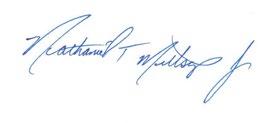
Mayer, John, honored by Ketterhagen Memorials
McCormick, Frederick Alexander, honored by Frederick and Virginia McCormick
Millsap, Marjorie, honored by Nathaniel
Millsap, Jr.
Oleson, Max, honored by Nancy Oleson
Pagenkopf, COL Don, honored by Donna Pagenkopf
Pedersen, Eric, honored by James Klubertanz
Pellett, Vernon, honored by Megan Pellett
Petek Jr, 2LT Victor honored by Brian Bieniek
Pierce, Sr, Edward, honored by Edward Pierce, Jr
Platz, William Thomas, honored by John Sheski
Ridlon, LT COL Anne, honored by James Parker
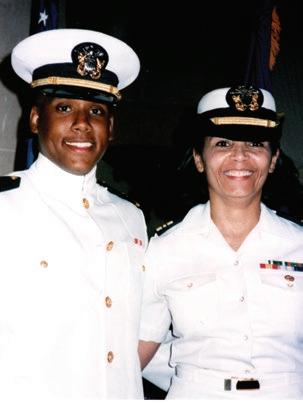
Ross, Ronald, honored by Keith and Katherine Lindstrand
Schellpeper, Charles, honored by Marilyn Olson and Suellyn Schellpeper
Schmidt, PFC Kenneth, honored by Jay Schmidt
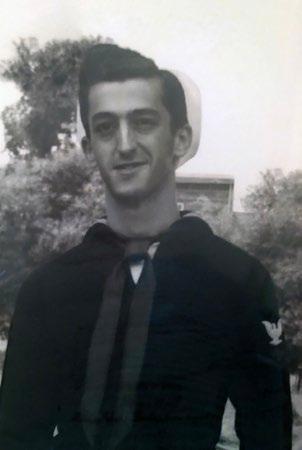

Schwendinger, Robert, honored by Michael Haack
In Loving Memory of Marshall
Sergenian, honored by The Sergenian
Family & Friends
Spencer, John, honored by Megan Pellett
Steiner, Terry Michael, honored by John Bird
Towers, John, honored by Leigh Barczi
Viner, Wayne, honored by Orrin Viner
Votaw, Jerry, honored by George Banda
Ward, Thomas & William, honored by Mary Ann Ward Decatur
Webster, Warren, honored by Mary Feldt
Wendt, Donald, honored by Gail Wendt
Wendt, Rodney, honored by Mike and Linda Fonger
Wilkening, MAJ GEN Albert, honored by Patricia Wilkening
Wise, PVT Brett Marlow, honored by Mitchell and Roslyn Wise
Zehren, Roy, honored by Geraldine Zehren
Zeitlin, PhD, Richard, honored by James Kelly
I am honored to be afforded the opportunity to be a part of the board of the Wisconsin Veterans Museum Foundation. Now as 2020 nears an end, I believe I can still do more to show my respect and appreciation.
I recently made a gift that supports preservation of our Wisconsin veterans’ histories. Why? Because I know and understand why “they deserve it,” and I want our veterans to be respectfully remembered. Will you join me? To make a gift online, visit wisvetsmuseum.com/ foundation/give-now/ or use the enclosed envelope to send in your donation.
For those who have already sent in your donation, thank you! We appreciate your support and wish you all health and happiness this holiday season.
With deepest respect and gratitude,
Daniel Checki Foundation Board President
24 WINTER 2020 THE BUGLE THE BUGLE 25
Daniel Checki, Jr, pictured in 1977, after the Marine Corps Basic School at Quantico, VA.
Then Ensign Nathaniel Millsap and his cousin Lieutenant CommanderJennifer Strother
View a special thank you message on our channel
Lieutenant Nathaniel T. Millsap Jr., USN, Ret.
Pictured in San Francisco, Daniel Checki, Sr, enlisted in the United States Navy in 1942 and trained as a corpsman.
THANK YOU DONORS
A most sincere thank you to all who donated from September through the end of November 2020. You are the reason we can provide quality programming and awardwinning exhibits.
Casey, Jr, John
Coe, John
Collins, Chaplain, Rev. Dean
Connell, Marilyn & Russell
Peloquin
Coronna, Mark
CTW Abbey Carpet & Floor
DAV Chapter 53
Deci, David & Diane Hart
Doylen, Michael
Duck, Holly
Fitzgerald, Kari
Fitzgerald, Jack & Joann
McCormick, Frederick & Ginny
McGuire, Mike
Mettert, Erin
Millane, James & Monica
Minter, Jennifer
Morledge, MD, John
Morris, Terrell
Mullins, Michael & Karen
Murrie, James
Nelson, Roger
Nettesheim, Daniel
Nowicki, Edward & Edith
Weber, Nicholas
Weier, John & Anita
Ziegenhorn, Mark
Zimbric, Gerald & Hazel
American Family
Insurance Dreams
Foundation
Lucid Visual Arts
Wisconsin Humanities
Council
Flatley, Tim
Gardon, Amy
Grimm, Philip
Guequierre, Mary
Haack, Michael
Hall, Tyson & Danielle
Harned, Lewis
Haynes, Amanda
Heinritz, Melinda & Mark
Nyberg, Edwin & Sally
Parks, Sylvie
Phillips, Gene
Porth, Guy
Powers, Brian
Race, John & Rita
Rasmussen, Steve
Reeve, James & Ann
Robbins, William & Chris
Just Coffee Cooperative
Millsap, Nathaniel
Reiland, Tim & Liz Orella
VFW 8483 Auxiliary
Helman, Gordon & Erika
Heuer, Martin
Howe, Thomas
Hundt, Michael & Lori
Icke, John & Karen
Isensee, Natalie
Jevens, Lowell
Rogan, COL (Ret) John
Rogers, Sue
Rusch, Lynn
Schellpeper Rohrer, Suellyn
Scher
Thomae, Dawn
Schroeder, John
American Legion Post 141 (Stuessy-Kuenzi Post)
American Legion Post 502 (Bloecher-Johnson Post)
Anderson, Donna
Andrews, John
Armstrong, Glen
Bach, Daniel
Barth, Paul
Berens, Todd
Best, Linda
Bieniek, Brian
Blondet, Ariel
Bloom, Wilson
Bonack, Donald
Bovre, Michael
Bowen, Ann
Brasser, Dale
Bublitz, James
Burkart, Andrew
Cain, Mark & Evelyn
Keller, Jeff & Jody
Ketterhagen Memorials LLC
Kiorpes, Kelly
Klecker, Cathy
Kleinsteiber, Larry
Kocum, Laura
Koeppen, John
Kolakowski, Peter & Jane
Koziczkowski, Daniel
Krueger, Carole
Krueger, Cal & Susie
Krogstad, Karen
Kurtz, James & Rebecca
Landwehr, Lawrence
Lawson, Edward
Leverance, James & Jane
Lipka, Michael
Luedtke, Leigh
Mani, Erin
Martinelli, Thomas
Mayo, Zachary
Sergenian, Diane
Sergenian, Timothy
Shulla, Peter
Smith, Gary
Smith, Ken & Linda
Speracino, Denise
Staab, Daniel
Stohlman, Samantha
Strobel, Kevin & Vickie
Stumpf, Charles & Diane
Sys, Joel
Toll, Kathryn
Ullman, Kathy
Van De Loop, John & Brenda
VFW Post 5716 (Hoeppner-Horn)
Vietnam Veterans of America
Vogel, Jean
Walker, Kate
For more than 100 years, the Wisconsin Veterans Museum has remained committed to honoring Wisconsin veterans and their role in shaping this nation’s history, through unique collections, awardwinning exhibits, and educational programs. Because of you, we can do even more to tell the stories of our veterans and ensure their legacies are never forgotten.

26 THE BUGLE
The Schott NYC A-2 is a reproduction of the classic aviator jacket worn during WWII. Made in the USA from pebbled cowhide, the A-2 has two front pockets, nylon twill lining and a snap down collar.
Frank Schaffer, Milwaukee, wore an A-2 while serving as the engineer/top turret Gunner on the B-24 “My Peach” during WWII.
The Cobi B-17 Flying Fortress is a fun and complicated build for block enthusiasts of all ages as it has 920 blocks and one figure.
Donald Wilkinson, Mazomanie, served on the B-17 “Qualified Quail” aboard which he flew 33 combat missions over Europe during WWII.
28 WINTER 2020 THE BUGLE WISCONSIN VETERANS MUSEUM 30 WEST MIFFLIN STREET MADISON, WI 53703 CALL 608.261.0536 or JOIN ONLINE at WWW.WISVETSMUSEUM.COM Click on Join | Give GIVE the GIFT of MEMBERSHIP Today!

















 Mary M. Kolar, Secretary Wisconsin Department
Mary M. Kolar, Secretary Wisconsin Department




 By: Russell Horton Reference Archivist
By: Russell Horton Reference Archivist
































 By Andrea Hoffman Collections Manager
By Andrea Hoffman Collections Manager
















